Review of VSG Control-Enabled Universal Compatibility Architecture for Future Power Systems with High-Penetration Renewable Generation
Abstract
1. Introduction
2. Outlook for Smart Grid Integration
2.1. The Challenges of a Conventional Power System
2.2. Knowledge of Power System Operation
2.3. Technical Gap for VSG
3. Modeling the VSG Control Strategy
3.1. SM Mathematic Model
3.2. Synchronization Mechanism
3.3. Implementation of VSG Control
4. VSG Applications of Power Electronics-Based Units
4.1. Wind Turbine
4.2. Solar Generation
4.3. Auxiliary ESS for Vulnerable Local System
4.4. Bidirectional EV Charger
4.5. Demand Response
5. VSG-Enabled Grid Service for Power Systems
5.1. Renewable Power Plant
5.2. Converter Station
5.3. Renewable DG
5.4. Microgrid
6. Universal Compatibility Architecture for Future Power System
7. Conclusions
Author Contributions
Funding
Acknowledgments
Conflicts of Interest
References
- Lopes, J.P.; Hatziargyriou, N.; Mutale, J.; Djapic, P.; Jenkins, N. Integrating distributed generation into electric power systems, A review of drivers, challenges and opportunities. Electr. Power Syst. Res. 2007, 77, 1189–1203. [Google Scholar] [CrossRef]
- BP Energy Outlook 2018. Available online: https://www.bp.com/en/global/corporate/energyeconomics/energyoutlook.html (accessed on 1 September 2018).
- Zhong, Q.C.; Blaabjerg, F.; Cecati, C. Power-Electronics-Enabled Autonomous Power Systems. IEEE Trans. Ind. Electron. 2017, 64, 5904–5906. [Google Scholar]
- Rocabert, J.; Luna, A.; Blaabjerg, F.; Rodriguez, P. Control of Power Converters in AC Microgrids. IEEE Trans. Power Electron. 2012, 27, 4734–4749. [Google Scholar] [CrossRef]
- Adefarati, T.; Bansal, R.C. Integration of Renewable Distributed Generators into Distribution System: A Review. IET Renew. Power Gen. 2016, 10, 873–884. [Google Scholar] [CrossRef]
- Moslehi, K.; Kumar, R. A Reliability Perspective of the Smart Grid. IEEE Trans. Smart Grid 2010, 1, 57–64. [Google Scholar] [CrossRef]
- Castronuovo, E.D.; Lopes, J.P. On the Optimization of the Daily Operation of a Wind-hydro power plant. IEEE Trans. Power Syst. 2004, 1599–1606. [Google Scholar] [CrossRef]
- Hernandez, L.; Baladron, C.; Aguiar, J.M.; Carro, B.; Sanchez-Esguevillas, A.J.; Lloret, J.; Massana, J. A Survey on Electric Power Demand Forecasting, Future Trends in Smart Grids, Microgrids and Smart Buildings. IEEE Commun. Surv. Tutor. 2014, 16, 1460–1495. [Google Scholar] [CrossRef]
- Costanzo, G.T.; Zhu, G.; Anjos, M.F.; Savard, G. A System Architecture for Autonomous Demand Side Load Management in Smart Buildings. IEEE Trans. Smart Grid 2012, 3, 2157–2165. [Google Scholar] [CrossRef]
- Bevrani, H.; Ise, T.; Miura, Y. Virtual Synchronous Generators, A survey and New Perspectives. Int. J. Electr. Power Energy Syst. 2014, 54, 244–254. [Google Scholar] [CrossRef]
- Hans-Peter, B.; Hesse, R. Virtual Synchronous Machine. In Proceedings of the 9th International Conference Electric Power Quality and Utilization, Barcelona, Spain, 9–11 October 2007. [Google Scholar]
- Visscher, K.; De Haan, S.W.H. Virtual Synchronous Machines (VSG’S) for Frequency Stabilization in Future Grids with a Significant Share of Decentralized Generation. In Proceedings of the CIRED Seminar 2008: Smart Grids for Distribution, Frankfurt, Germany, 23–24 June 2008. [Google Scholar]
- Zhong, Q.C.; Weiss, G. Synchronverters, Inverters That Mimic Synchronous Generators. IEEE Trans. Ind. Electron. 2011, 58, 1259–1267. [Google Scholar] [CrossRef]
- Zhong, Q.C.; Nguyen, P.L.; Ma, Z.; Sheng, W. Self-Synchronized Synchronverters, Inverters Without a Dedicated Synchronous Unit. IEEE Trans. Power Electron. 2014, 29, 617–630. [Google Scholar] [CrossRef]
- Zhong, Q.-C. Power-Electronics-Enabled Autonomous Power Systems, Architecture and Technical Routes. IEEE Trans. Ind. Electron. 2017, 64, 5907–5918. [Google Scholar] [CrossRef]
- Stephen, J.C. Electric Machinery Fundamentals; McGraw-Hill Education: New York, NY, USA, 2012; pp. 230–267. [Google Scholar]
- Stephen, D.U. Fitzgerald & Kingsley’s Electric Machinery; McGraw-Hill Education: New York, NY, USA, 2013; pp. 262–344. [Google Scholar]
- Zhong, Q.C.; Hornik, T. Control of Power Inverters in Renewable Energy and Smart Grid Integration; John Wiley & Sons: Hoboken, NJ, USA, 2012; pp. 277–296. [Google Scholar]
- Machowski, J.; Bialek, J.W.; Bumby, J.R. Power System Dynamics and Stability; Wiley: Chichester, UK, 1997; Chapter 5. [Google Scholar]
- Kimbark, E.W. Power System Stability, Volume III Synchronous Machines; John Wiley & Sons, Inc.: New York, NY, USA, 1956; Chapter XIV. [Google Scholar]
- Hesse, R.; Turschner, D.; Beck, H.-P. Micro grid stabilization using the Virtual Synchronous Machine (VISMA). In Proceedings of the International Conference on Renewable Energies and Power Quality, ICREPQ’09, Valencia, Spain, 15-17 April 2009; p. 6. [Google Scholar]
- Pelczar, C.; Stubbe, M.; Beck, H.-P.; Zirn, O. FPGA Current Controller for the Virtual Synchronous Machine. In Proceedings of the International Exhibition and Conference for Power Electronics, Intelligent Motion, Renewable Energy and Energy Management PCIM Europe, Nuremberg, Germany, 8–10 May 2012; pp. 138–145. [Google Scholar]
- Chen, Y.; Hasse, R.; Turschner, D.; Beck, H.-P. Comparison of methods for implementing virtual synchronous machine on inverters. In Proceedings of the International Conference on Renewable Energies and Power Quality, ICREPQ’12, Santiago de Compostela, Spain, 28–30 March 2012; pp. 1–6. [Google Scholar]
- Chen, Y.; Hesse, R.; Turschner, D.; Beck, H.-P. Dynamic Properties of the Virtual Synchronous Machine (VSIMA). In Proceedings of the International Conference on Renewable Energies and Power Quality, ICREPQ’11, Las Palmas, Spain, 13–15 April 2011; pp. 1–5. [Google Scholar]
- Chen, Y.; Hesse, R.; Turschner, D.; Beck, H.-P. Improving the Grid Power Quality Using Virtual Synchronous Machines. In Proceedings of the 2011 International Conference on Power Engineering, Energy and Electrical Drives, PowerEng 2011, Torremolinos, Malaga, Spain, 11–13 May 2011; pp. 1–6. [Google Scholar]
- Chen, Y.; Hesse, R.; Turschner, D.; Beck, H.-P. Investigation of the Virtual Synchronous Machine in the Island Mode. In Proceedings of the 2012 3rd IEEE Innovative Smart Grid Technologies Europe Conference, Berlin, Germany, 15–17 October 2012; pp. 1–6. [Google Scholar]
- Driesen, J.; Visscher, K. Virtual Synchronous Generators. In Proceedings of the IEEE Power and Energy Society 2008 General Meeting, Conversion and Delivery of Energy in the 21st, Pittsburgh, PA, USA, 20–24 July 2008; pp. 1–3. [Google Scholar]
- D’Arco, S.; Suul, J.A. Virtual Synchronous Machines—Classification of Implementations and Analysis of Equivalence to Droop Controllers for Microgrids. In Proceedings of the IEEE Powertech Grenoble Conference, Grenoble, France, 16–20 June 2013. [Google Scholar]
- Alrajhi Alsiraji, H.; El-Shatshat, R. Comprehensive assessment of virtual synchronous machine based voltage source converter controllers. IET Gen. Transm. Distrib. 2017, 11, 1762–1769. [Google Scholar] [CrossRef]
- Natarajan, V.; Weiss, G. Synchronverters with Better Stability Due to Virtual Inductors, Virtual Capacitors, and Anti-Windup. IEEE Trans. Ind. Electron. 2017, 64, 5994–6004. [Google Scholar] [CrossRef]
- Wu, H.; Ruan, X.; Yang, D.; Chen, X.; Zhao, W.; Lv, Z.; Zhong, Q.C. Small-Signal Modeling and Parameters Design for Virtual Synchronous Generators. IEEE Trans. Ind. Electron. 2016, 63, 4292–4303. [Google Scholar] [CrossRef]
- Singh, B.; Mahanty, R.; Singh, S.P. Social welfare maximization for congestion management in multiutility market using improved PSO incorporating transmission loss cost allocation. Int. Trans. Electr. Energy Syst. 2018, 28. [Google Scholar] [CrossRef]
- Alipoor, J.; Miura, Y.; Ise, T. Stability Assessment and Optimization Methods for Microgrid With Multiple VSG Units. IEEE Trans. Smart Grid 2018, 9, 1462–1471. [Google Scholar] [CrossRef]
- Wang, Y.; Meng, J.; Zhang, X.; Xu, L. Control of PMSG-Based Wind Turbines for System Inertial Response and Power Oscillation Damping. IEEE Trans. Sustain. Energy 2015, 6, 565–574. [Google Scholar] [CrossRef]
- Wang, S.; Hu, J.; Yuan, X. Virtual Synchronous Control for Grid-Connected DFIG-Based Wind Turbines. IEEE J. Emerg. Sel. Top. Power Electron. 2015, 3, 932–944. [Google Scholar] [CrossRef]
- Wang, S.; Hu, J.; Yuan, X.; Sun, L. On Inertial Dynamics of Virtual-Synchronous-Controlled DFIG-Based Wind Turbines. IEEE Trans. Energy Convers. 2015, 30, 1691–1702. [Google Scholar] [CrossRef]
- Ma, Y.; Cao, W.; Yang, L.; Wang, F.F.; Tolbert, L.M. Virtual Synchronous Generator Control of Full Converter Wind Turbines with Short-Term Energy Storage. IEEE Trans. Ind. Electron. 2017, 64, 8821–8831. [Google Scholar] [CrossRef]
- Alatrash, H.; Mensah, A.; Mark, E.; Haddad, G.; Enslin, J. Generator Emulation Controls for Photovoltaic Inverters. In Proceedings of the 8th International Conference on Power Electronics—ECCE Asia, Jeju, Korea, 30 May–3 June 2011; pp. 996–1011. [Google Scholar]
- Alatrash, H.; Mensah, A.; Mark, E.; Haddad, G.; Enslin, J. Generator Emulation Controls for Photovoltaic Inverters. IEEE Trans. Smart Grid 2012, 3, 996–1011. [Google Scholar] [CrossRef]
- Yan, R.; Saha, T.K.; Meredith, P.; Ananth, A.; Hossain, M.I. Megawatt-scale solar variability study, an experience from a 1.2 MWp photovoltaic system in Australia over three years. IET Renew. Power Gener. 2016, 10, 1229–1236. [Google Scholar] [CrossRef]
- Watson, J.D.; Watson, N.R.; Santos-Martin, D.; Wood, A.R.; Lemon, S.; Miller, A.J. Impact of solar photovoltaics on the low-voltage distribution network in New Zealand. IET Gener. Transm. Distrib. 2016, 10, 1–9. [Google Scholar] [CrossRef]
- Remon, D.; Cañizares, C.A.; Rodriguez, P. Impact of 100-MW-scale PV plants with synchronous power controllers on power system stability in northern Chile. IET Gener. Transm. Distrib. 2017, 11, 2958–2964. [Google Scholar] [CrossRef]
- Fang, L.; Niu, Y.; Zu, Q.; Wang, S. Energy management strategy based on energy storage equalization technology and transferable load. Int. Trans. Electr. Energy Syst. 2018, 28, e2599. [Google Scholar] [CrossRef]
- Sivakumar, P.; Arutchelvi, M.S. Modified composite power control strategy for grid connected wind-PV systems with unbalanced nonlinear current. Int. Trans. Electr. Energy Syst. 2018, 28, e2587. [Google Scholar] [CrossRef]
- Miguel, A.; Torres, L.; Luiz, A.C.; Lopes Luis, A.; Morán, T.; José, R.; Espinoza, C. Self-Tuning Virtual Synchronous Machine, A Control Strategy for Energy Storage Systems to Support Dynamic Frequency Control. IEEE Trans. Energy Convers. 2014, 29, 833–840. [Google Scholar]
- The Information Council for Road Traffic in Norway, National Sales Statistics for 2015. Available online: http//www.ofvas.no/bilsalget-i2015/category679.html (accessed on 1 September 2016).
- Lopes, J.A.P.; Soares, F.J.; Almeida, P.M.R. Integration of electric vehicles in the electric power systems. Proc. IEEE 2011, 99, 168–183. [Google Scholar] [CrossRef]
- Yilmaz, M.; Krein, P.T. Review of the impact of vehicle-to-grid technologies on distribution systems and utility interfaces. IEEE Trans. Power Electron. 2013, 28, 5673–5689. [Google Scholar] [CrossRef]
- Tan, K.M.; Ramachandaramurthy, V.K.; Yong, J.Y. Integration of electric vehicles in smart grid, A review on vehicle to grid technologies and optimization techniques. Sustain. Energy 2016, 53, 720–732. [Google Scholar] [CrossRef]
- Berigai, A.; Rakesh, R.; Sabha, M.; Arya, R. Bidirectional converter for electric vehicle battery charging with power quality features. Int. Trans. Electr. Energy Syst. 2018, 28, e2589. [Google Scholar] [CrossRef]
- Suul, J.A.; D’Arco, S.; Guidi, G. Virtual Synchronous Machine-Based Control of a Single-Phase Bi-Directional Battery Charger for Providing Vehicle-to-Grid Services. IEEE Trans. Ind. Appl. 2016, 52, 3234–3244. [Google Scholar] [CrossRef]
- Gellings, C.W. The concept of demand-side management for electric utilities. Proc. IEEE 1985, 73, 1468–1470. [Google Scholar] [CrossRef]
- Molderink, A.; Bakker, V.; Bosman, M.G.C.; Hurink, J.L.; Smit, G.J.M. Domestic energy management methodology for optimizing efficiency in smart grids. In Proceedings of the IEEE Bucharest PowerTech, Bucharest, Romania, 28 June–2 July 2009; pp. 1–7. [Google Scholar]
- Dai, Y.; Gao, Y.; Gao, H.; Zhu, H. A demand response approach considering retailer incentive mechanism based on Stackelberg game in smart grid with multi retailers. Int. Trans. Electr. Energy Syst. 2018, 28, e2590. [Google Scholar] [CrossRef]
- Vahedipour-Dahraie, M.; Najafi, H.R.; Anvari-Moghaddam, A.; Guerrero, J.M. Security-constrained unit commitment in AC microgrids considering stochastic price-based demand response and renewable generation. Int. Trans. Electr. Energy Syst. 2018, 28, e2596. [Google Scholar] [CrossRef]
- Shi, J.; Oren, S.S. Stochastic unit commitment with topology control recourse for power system with large-scale renewable integration. IEEE Trans. Power Syst. 2018, 33, 3315–3324. [Google Scholar] [CrossRef]
- Ulbig, A.; Borsche, T.S.; Andersson, G. Impact of low rotational inertia on power system stability and operation. Proc. IFAC World Congr. 2014, 47, 7290–7297. [Google Scholar] [CrossRef]
- Ashton, P.; Saunders, C.; Taylor, G.; Carter, A.; Bradley, M. Inertia estimation of the GB power system using synchrophasor measurements. IEEE Trans. Power Syst. 2015, 30, 701–709. [Google Scholar] [CrossRef]
- Ela, E.; Gevorgian, V.; Tuohy, A.; Kirby, B.; Milligan, M.; O’Malley, M. Market designs for the primary frequency response ancillary service— Part I, Motivation and design. IEEE Trans. Power Syst. 2014, 29, 421–431. [Google Scholar] [CrossRef]
- Poolla, B.K.; Bolognani, S.; Dörfler, F. Optimal Placement of Virtual Inertia in Power Grids. IEEE Trans. Autom. Control 2017, 62, 6209–6220. [Google Scholar] [CrossRef]
- Ummels, B.C.; Kling, W.L.; Pelgrum, E. Integration of large-scale wind power and use of energy storage in the Netherlands’ electricity supply. IET Renewable Power Gen. 2008, 2, 34–36. [Google Scholar] [CrossRef]
- O’Dwyer, C.; Ryan, L.; Flynn, D. Efficient Large-Scale Energy Storage Dispatch, Challenges in Future High Renewable Systems. IEEE Trans. Power Syst. 2017, 32, 3439–3450. [Google Scholar] [CrossRef]
- Yang, Y.; Ye, Q.; Tung, L.J.; Greenleaf, M.; Li, H. Integrated Size and Energy Management Design of Battery Storage to Enhance Grid Integration of Large-Scale PV Power Plants. IEEE Trans. Ind. Electron. 2018, 65, 394–402. [Google Scholar] [CrossRef]
- Wang, K.; Qi, C.; Huang, X.; Li, G. Large disturbance stability evaluation of interconnected multi-inverter power grids with VSG model. J. Eng. 2017, 2017, 2483–2488. [Google Scholar] [CrossRef]
- Li, G.; Li, G.; Li, H.; Zhao, C.; Yin, M. Research on hybrid HVDC. Proc. Int. Conf. Power Syst. Technol. 2004, 2, 1607–1612. [Google Scholar]
- Torres-Olguin, R.E.; Molinas, M.; Undeland, T.M. A controller in DQ synchronous reference frame for hybrid HVDC transmission system. Proc. Int. Power Electron. Conf. 2010, 376–383. [Google Scholar]
- Kotb, O.; Sood, V.K. A hybrid HVDC transmission system supplying a passive load. In Proceedings of the 2010 IEEE Electrical Power & Energy Conference, Halifax, NS, Canada, 25–27 August 2010; pp. 1–5. [Google Scholar]
- Dong, S.; Chi, Y.; Li, Y. Active Voltage Feedback Control for Hybrid Multiterminal HVDC System Adopting Improved Synchronverters. IEEE Trans. Power Deliv. 2016, 31, 445–455. [Google Scholar] [CrossRef]
- Saric, M.; Hivziefendic, J.; Konjic, T.; Ktena, A. Distributed generation allocation considering uncertainties. Int. Trans. Electr. Energy Syst. 2018, 28, e2585. [Google Scholar] [CrossRef]
- Guide for Planning DC Links Terminating at AC Systems Locations Having Low Short-Circuit Capacities, Part I, AC/DC Interaction Phenomena; IEEE Standard: New York, NY, USA, 1997.
- Lu, S.; Xu, Z.; Xiao, L.; Jiang, W.; Bie, X. Evaluation and Enhancement of Control Strategies for VSC Stations Under Weak Grid Strengths. IEEE Trans. Power Syst. 2018, 33, 1836–1847. [Google Scholar] [CrossRef]
- Hamzeh, M.; Ghazanfari, A.; Mohamed, Y.A.; Karimi, Y. Modeling and design of an oscillatory current-sharing control strategy in DC microgrids. IEEE Trans. Ind. Electron. 2015, 62, 6647–6657. [Google Scholar] [CrossRef]
- Huang, P.; Liu, P.; Xiao, W.; el Moursi, M.S. A novel droop-based average voltage sharing control strategy for DC microgrids. IEEE Trans. Smart Grid 2015, 6, 1096–1106. [Google Scholar] [CrossRef]
- Lu, X.; Sun, K.; Guerrero, J.M.; Vasquez, J.C.; Huang, L. State-of charge balance using adaptive droop control for distributed energy storage systems in DC microgrid applications. IEEE Trans. Ind. Electron. 2014, 61, 2804–2815. [Google Scholar] [CrossRef]
- Wu, W.; Chen, Y.; Luo, A.; Zhou, L.; Zhou, X.; Yang, L.; Dong, Y.; Guerrero, J.M. A Virtual Inertia Control Strategy for DC Microgrids Analogized with Virtual Synchronous Machines. IEEE Trans. Ind. Electron. 2017, 64, 6005–6016. [Google Scholar] [CrossRef]
- Majumder, R. A hybrid microgrid with dc connection at back to back con converters. IEEE Trans. Smart Grid 2014, 5, 251–259. [Google Scholar] [CrossRef]
- Alsiraji, H.A.; Radwan, A.A.; El-Shatshat, R. Modelling and analysis of a synchronous machine-emulated active intertying converter in hybrid AC/DC microgrids. IET Gener. Transm. Distrib. 2018, 12, 2539–2548. [Google Scholar] [CrossRef]
- Zhong, Q.-C. Virtual Synchronous Machines—A unified interface for smart grid integration. IEEE Power Electron. Mag. 2016, 3, 18–27. [Google Scholar] [CrossRef]
- Li, H.; Eseye, A.T.; Zhang, J.; Zheng, D. Optimal energy management for industrial microgrids with high-penetration renewables. Prot. Control Mod. Power Syst. 2017, 2, 122–135. [Google Scholar] [CrossRef]
- Gaber, M.; Shabib, G.; Elbaset, A.A.; Mitani, Y. Optimized coordinated control of LFC and SMES to enhance requency stability of a real multi-source power system considering high renewable energy penetration. Prot. Control Mod. Power Syst. 2018, 3, 407–421. [Google Scholar]
- Gaber, M.; Mohamed, E.A.; Shabib, G.; Elbaset, A.A.; Mitani, Y. Microgrid dynamic security considering high penetration of renewable energy. Prot. Control Mod. Power Syst. 2018, 3, 236–246. [Google Scholar]
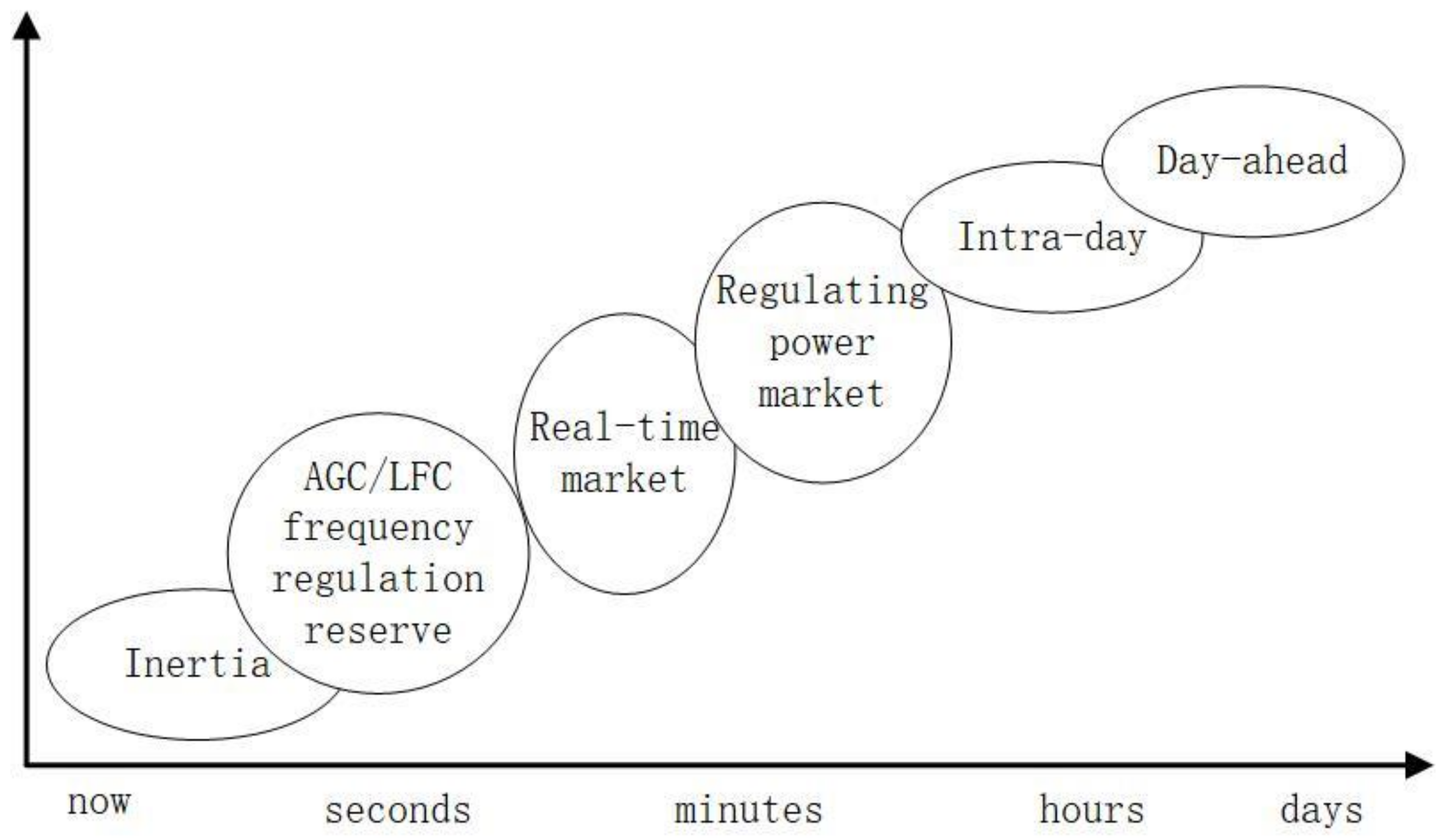
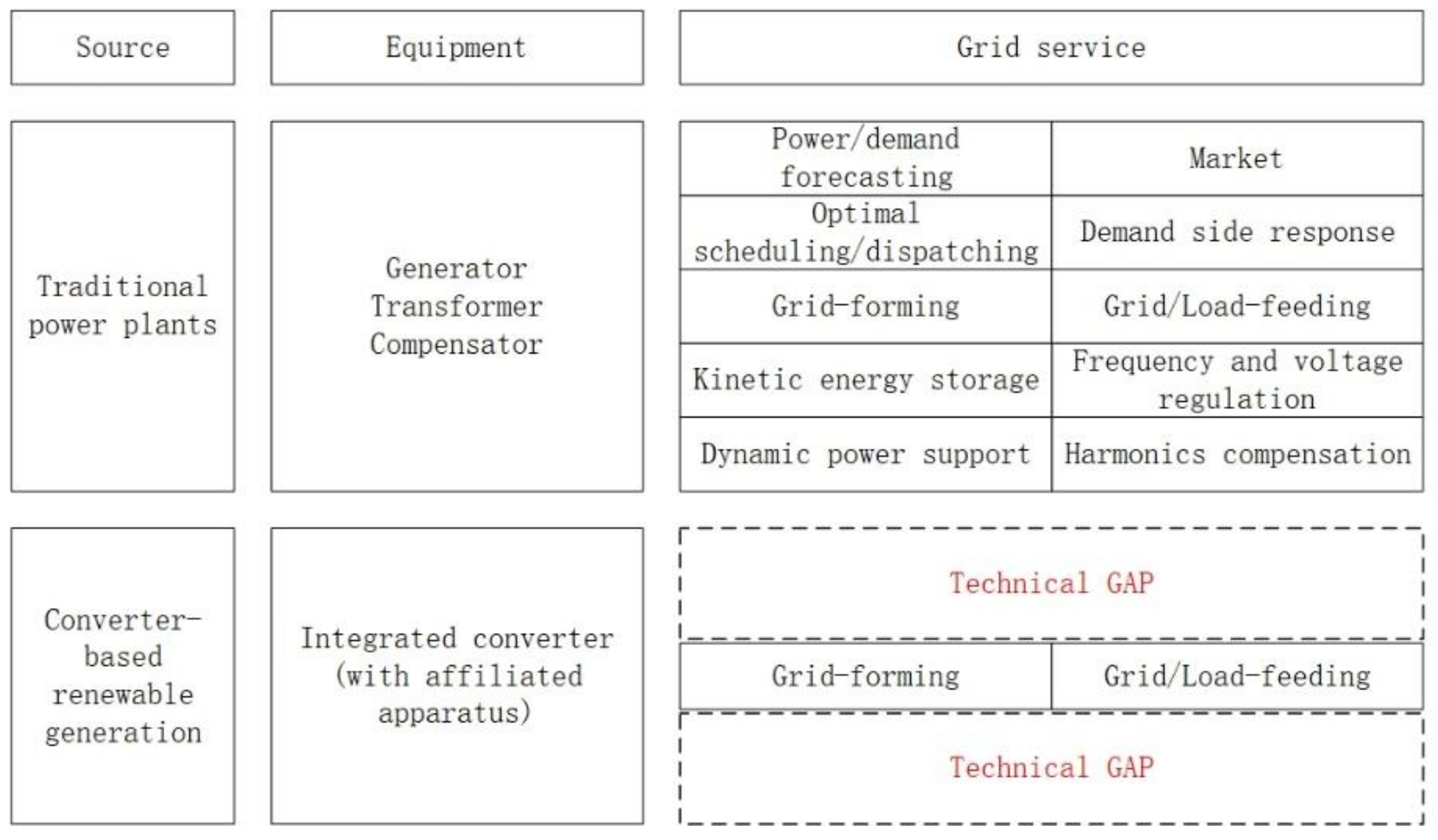



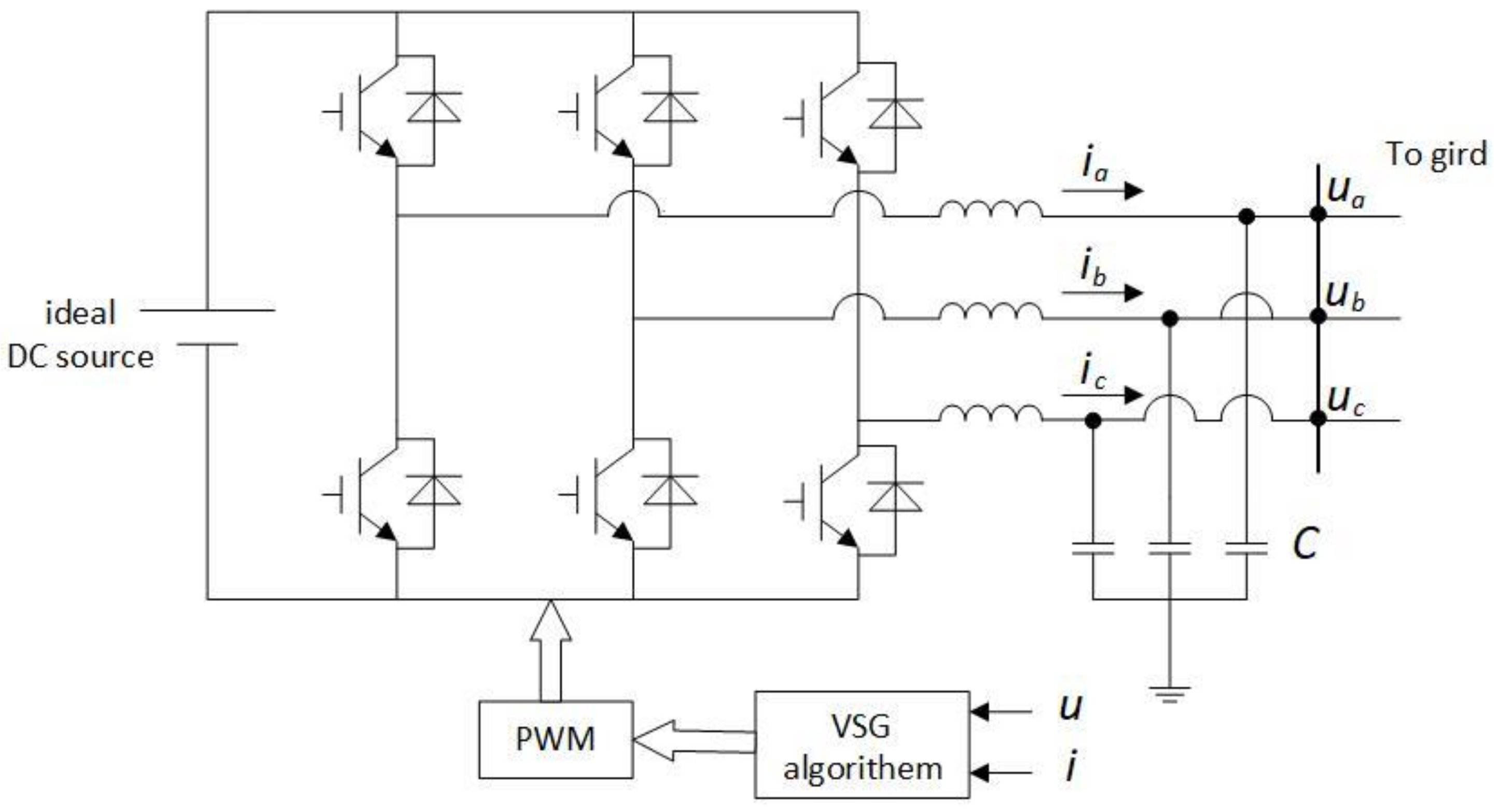

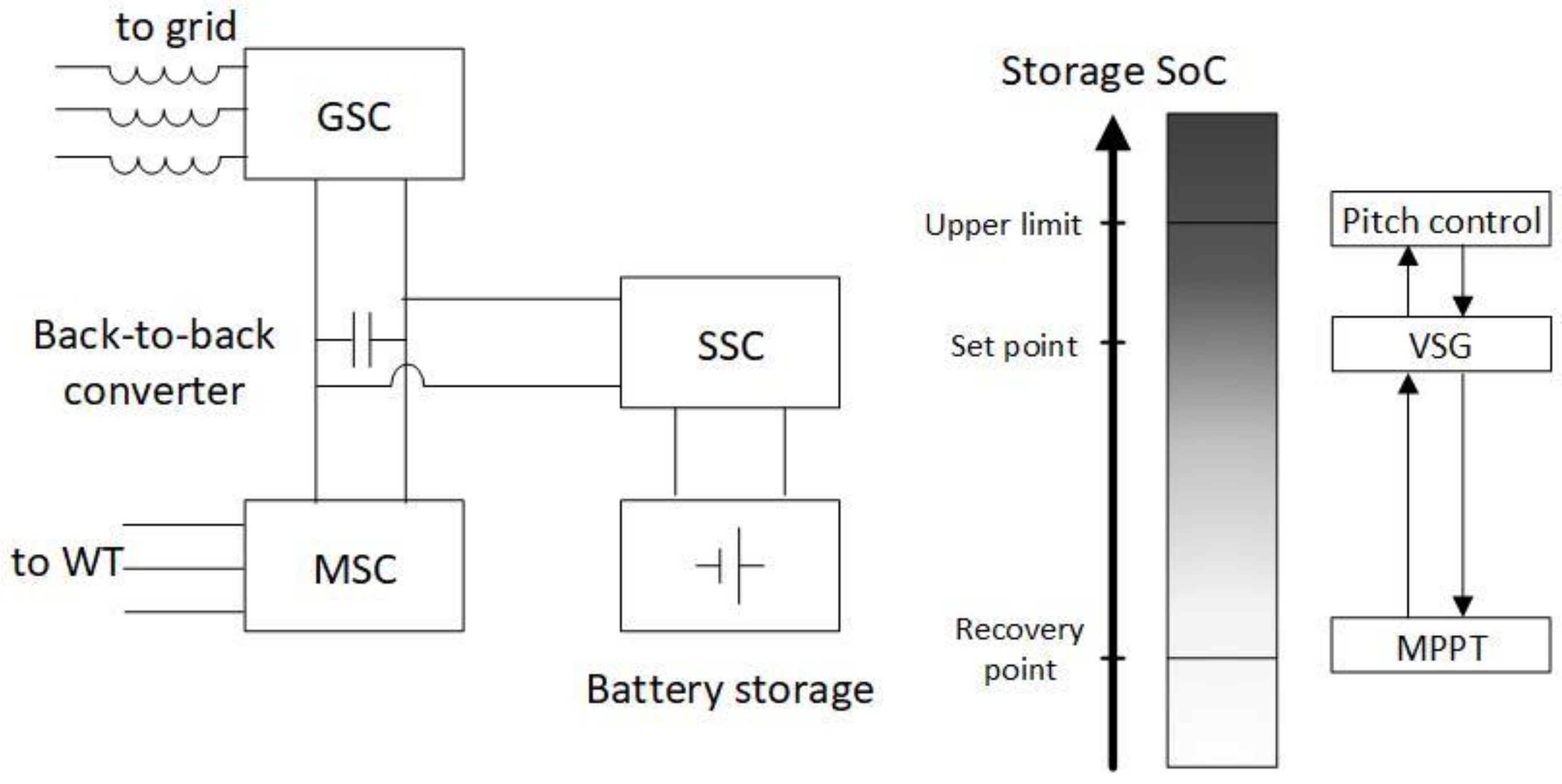
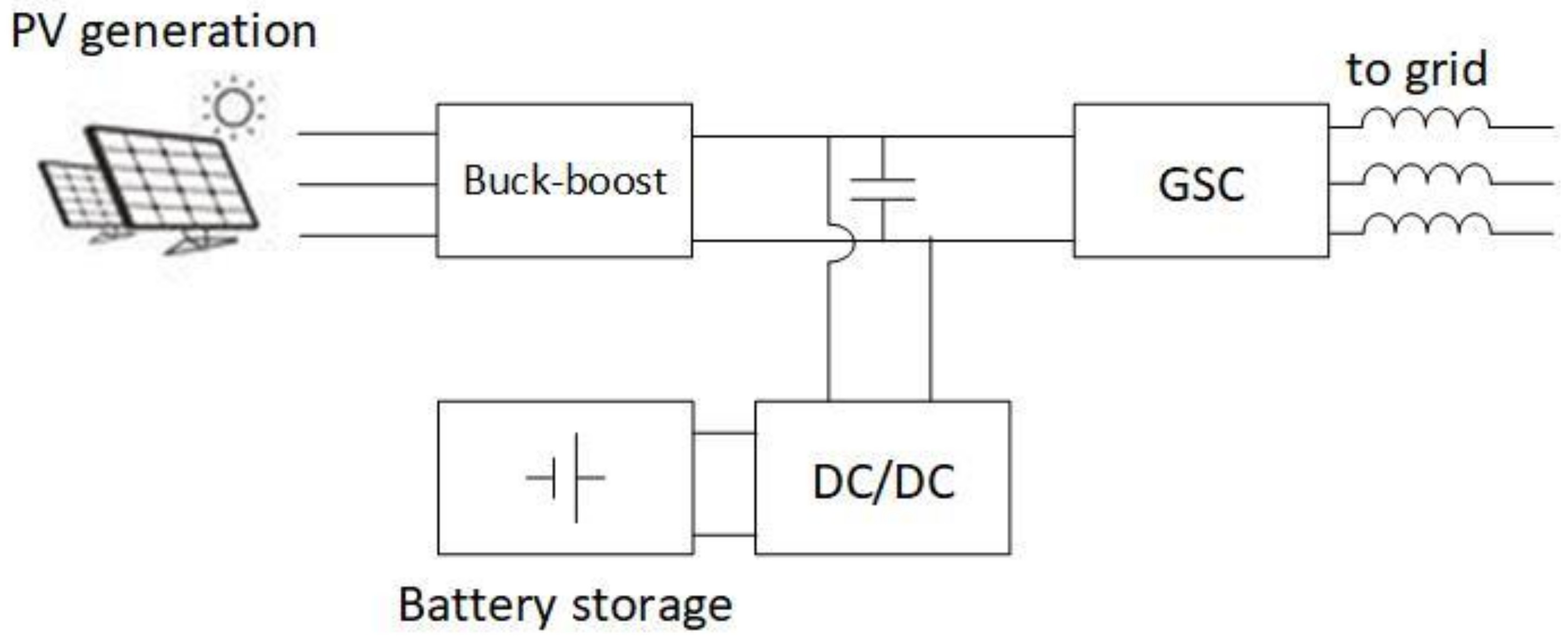
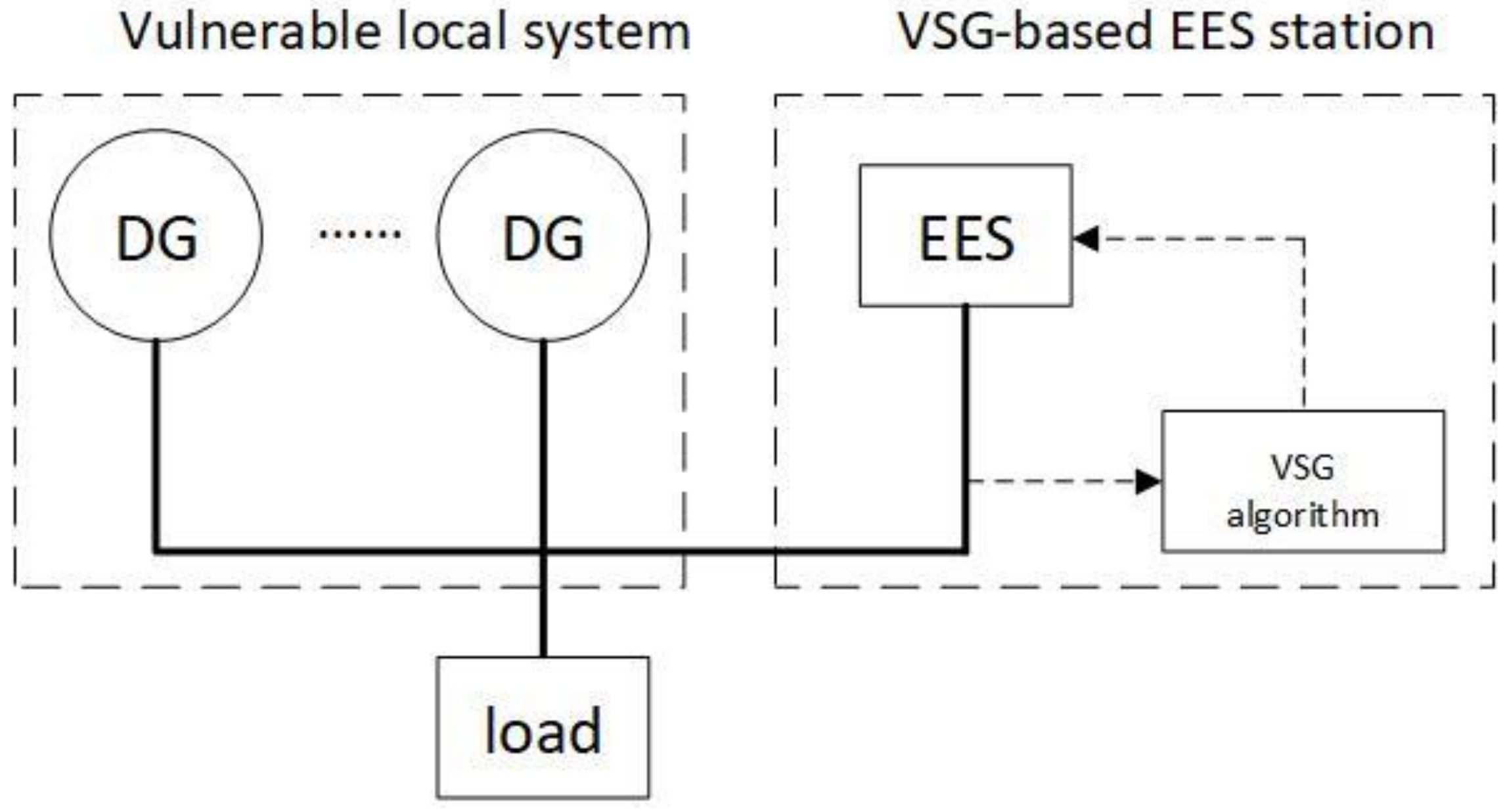
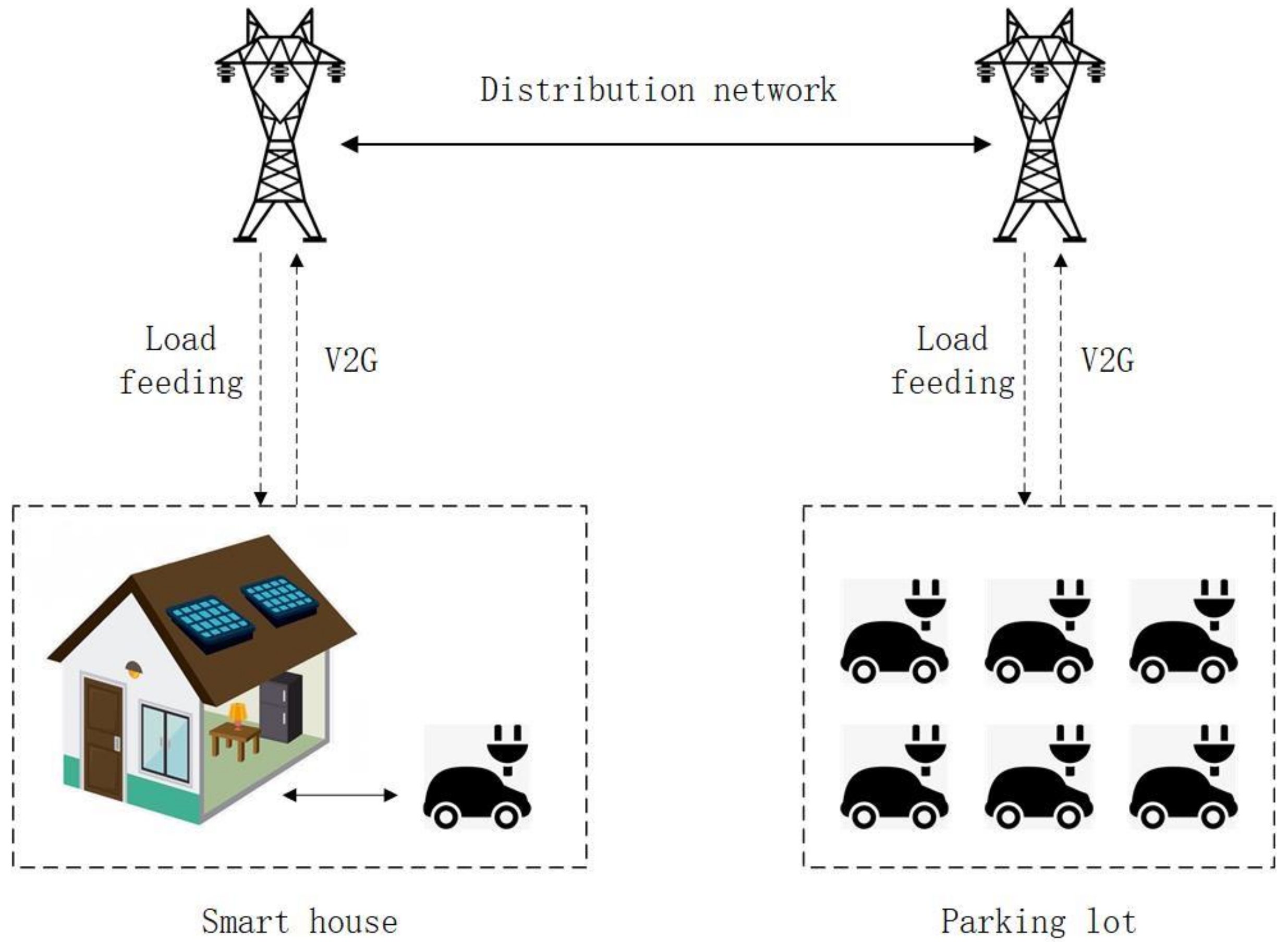
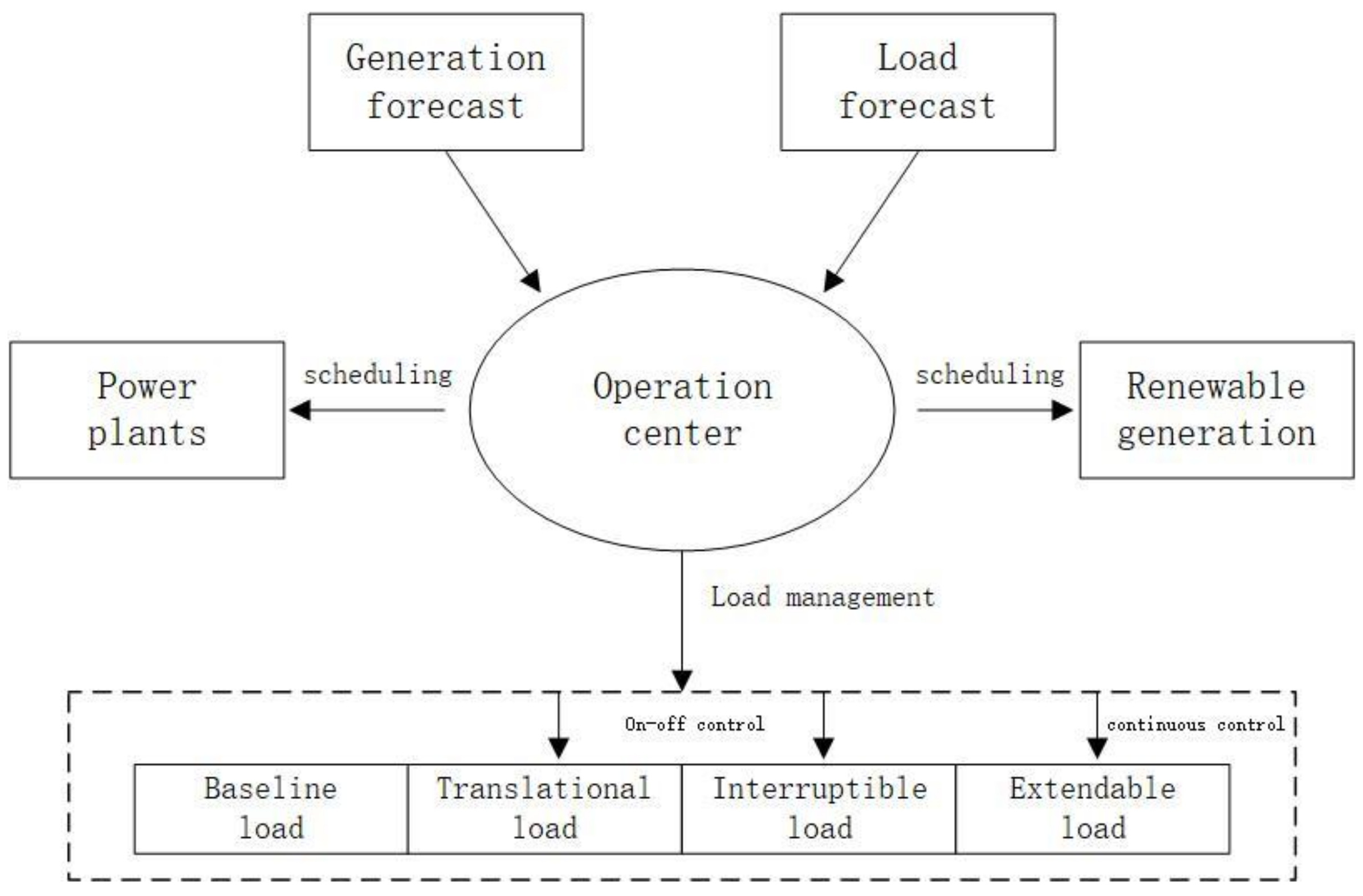
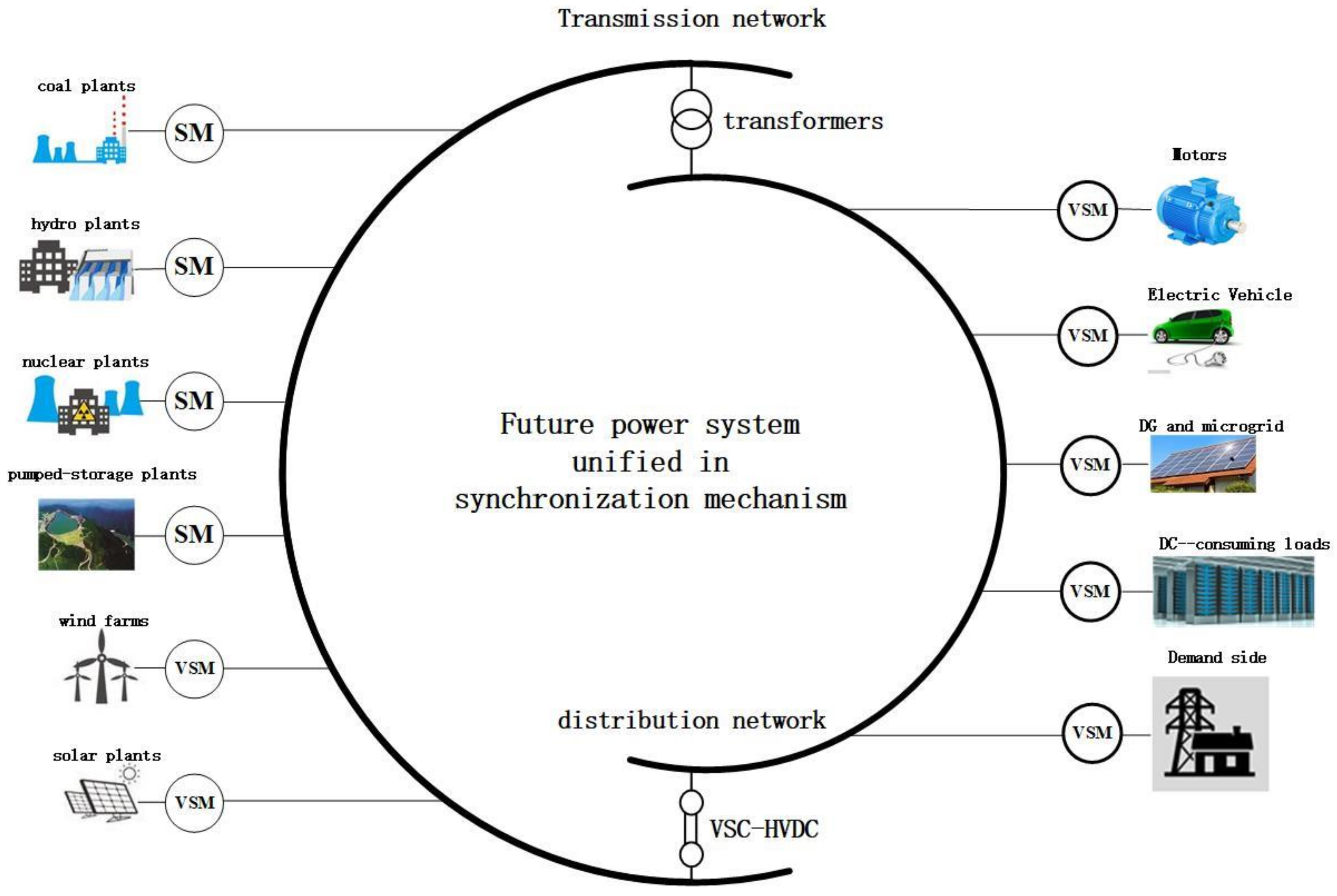

| Model | Model Implementation | General Comments |
|---|---|---|
| Seventh order | Electric, magnetic, swing equation of stator and rotor winding | Full representation of SG dynamics. |
| Fifth or fourth order | Electric, magnetic, swing equation of stator winding | Only stator winding is considered compared to seventh-order model. |
| Second order | Swing equation and voltage amplitude given by the reactive power controller | Simple scheme for converter implementation for a close imitation. |
| First order | Inertial emulation by power response calculated from grid voltage tracking | Incapable of isolated operation. |
© 2019 by the authors. Licensee MDPI, Basel, Switzerland. This article is an open access article distributed under the terms and conditions of the Creative Commons Attribution (CC BY) license (http://creativecommons.org/licenses/by/4.0/).
Share and Cite
Yan, X.; Zhang, W. Review of VSG Control-Enabled Universal Compatibility Architecture for Future Power Systems with High-Penetration Renewable Generation. Appl. Sci. 2019, 9, 1484. https://doi.org/10.3390/app9071484
Yan X, Zhang W. Review of VSG Control-Enabled Universal Compatibility Architecture for Future Power Systems with High-Penetration Renewable Generation. Applied Sciences. 2019; 9(7):1484. https://doi.org/10.3390/app9071484
Chicago/Turabian StyleYan, Xiangwu, and Weichao Zhang. 2019. "Review of VSG Control-Enabled Universal Compatibility Architecture for Future Power Systems with High-Penetration Renewable Generation" Applied Sciences 9, no. 7: 1484. https://doi.org/10.3390/app9071484
APA StyleYan, X., & Zhang, W. (2019). Review of VSG Control-Enabled Universal Compatibility Architecture for Future Power Systems with High-Penetration Renewable Generation. Applied Sciences, 9(7), 1484. https://doi.org/10.3390/app9071484





